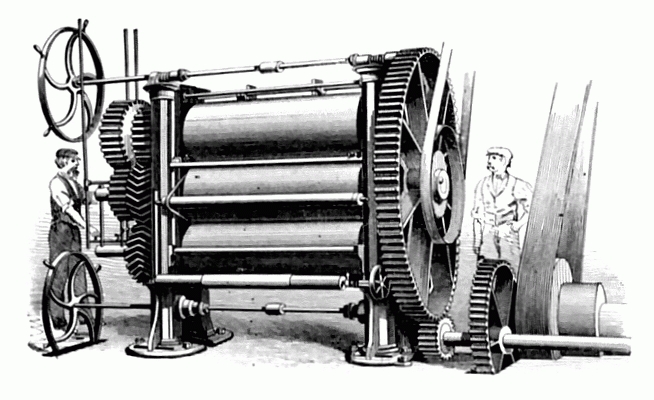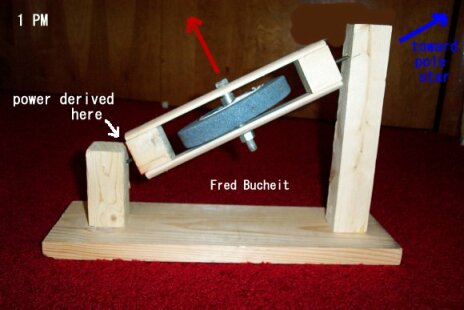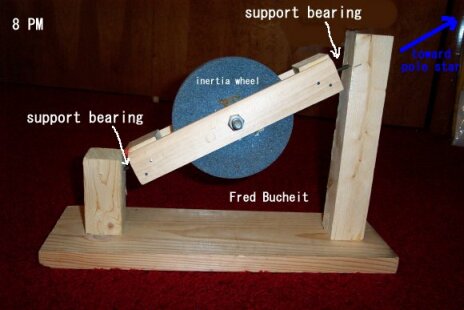
Will They Work? Here's where we store ideas that might have a chance of working as claimed, even if they might be a bit "far-out". These are not intended to be perpetual motion machines, or over-unity devices. Most of them are proposals to tap into existing environmental energy sources, wind, falling water, atmospheric pressure changes, ocean tides, ocean temperature gradients, and even the rotation of the Earth. None of these make claims of violating any laws of physics. But as with any exotic mechanism, there may be "gotchas" which make them unworkable, or at least impractical.
Motion faster than the mover.
A few years ago there was considerable web discussion of a vehicle that could use wind power to move itself directly downwind faster than the ground speed of the wind itself. Some thought the notion impossible. And when it was reported that such a wheeled vehicle with a large propeller driven by its wheels was actually clocked speeding directly downwind at 2.8 times the wind's ground speed, some thought it a hoax.You have to admit that the idea sounds suspicious when first encountered. It seems like getting something for nothing, or the Baron Munchausen bootstrap principle (lifting yourself by pulling up your bootstraps).
How might this be done, and are there other mechanisms that can move faster than the agend moving them? What is the physical explanation?
Answer: DDWFTTW.
A related idea is to make a device that moves directly upwind faster than the wind. This, too, has been done, and there are many simple devices that accomplish motion opposite to the agent moving them. A web page about these is in preparation.
The Gyrogenerator
Fred Bucheit sends us this sneaky idea for stealing some of the rotational energy of the earth. He sends pictures of a model (not a working one) to make the geometry clear.
 |
 |
A sturdy frame is free to rotate about two support bearings. In this frame is a heavy wheel (blue), free to rotate. The frame is aligned with its bearings along a line parallel to the earth's axis. The bearings are supported by a sturdy frame bolted to the floor.
Now cause the inertia wheel to spin at high speed. Just as a gyroscope, the rotation axis of the wheel will tend to remain pointing to the same place in the heavens as the earth rotates (red arrow). So as the earth turns, the outer frame turns relative to the inner frame. Energy can be tapped from either of the bearings labeled in the picture.
One needn't worry that zillions of such machines will significantly slow the rotation of the earth. A simple calculation of the rotation energy of the earth shows that we could power all human activities this way and not even notice the lengthening of the day. But how many of these devices would we need to do that? (Exercise for the reader.)
There was a discussion of this on PHYS-L in December 2003 under the heading "gyrogenerator". However, I suspect there must be a simpler and more conceptual analysis.
 |
Reverse Osmosis.
A correspondent from New Zealand sends us this ingenious idea that he saw in the Dec. 1971 Scientific American Amateur Scientist column. We'll let him describe it:
Osmosis is where water flows through a semi-permeable membrane from a less concentrated to more concentrated solution. Reverse osmosis is where water flows through the membrane from a strong solution to a weak one. Of course you have to have pressure behind it to make it flow the wrong way. To get fresh water to flow out of seawater through a membrane takes a pressure of about 20 atmospheres (from what I've been told). This is the basis of some desalinating devices used on yachts.Anyway, what you do is get a very long pipe with a semi-permeable plug in the end and fill it with fresh water and lower it over the side of a boat so that one end is a few metres above the surface and the other with the plug is at the bottom at the deepest ocean trench you can find—say 12 km down or however deep the ocean gets. Now, at this depth the head of salt water in the ocean round the pipe is more than 20 atmospheres, say 21 atmospheres, so fresh water flows out of the ocean salt water into the fresh water pipe. The fresh water will rise about 10 m (21 - 20 = 1 atmosphere) above the surface somewhat like an artesian well. You may have to adjust the depths a bit depending on the density of the sea water but the principle seems plausible.
Not only will this device give an endless stream of fresh water but can be used to run a small generator.
The figure shows the tube in the ocean, its top end curved to direct water to the little waterwheel, W. You've gotta love perpetual motion proposals that are so simple, with no moving parts, and hold promise of solving our world energy problems and our fresh water resource problems as well. That is, if only we can get enough of these machines running at once.
Pressure in the ocean varies linearly with depth, increasing by about 1 atmosphere for each 10 meters of depth. So the pressure in the ocean at a depth of about 200 meters (700 feet) is 20 atmospheres above atmospheric pressure. This fact may or may not be helpful.
Solution left as an exercise for the student. An answer is given in the April. 1972 Scientific American, but it is a bit indirect. See also the June 1971 issue. Here's my answer.
Re: Answers left as exercise for the student. Send your answers to the address
shown at the right. The
earliest good answer(s) that arrive may be posted here, with credit to author.
I will post (at my discretion) answers that are simple to explain, clear,
correct, perceptive, and that stimulates thinking and further discussion.
Posted answers, whether written by me or by others, do not always represent
the final word on a given proposal. On several occasions perceptive readers
have noticed things we missed, or suggested simpler ways to explain something.
So don't hesitate to skeptically rethink given "answers".
While I welcome submission of new or innovative perpetual motion puzzles,
I assume no obligation to respond in detail to all of them. In particular,
I cannot be expected to analyze vague proposals, overly and unnecssarily
complicated designs, nor ideas which are simply variations of classics found
in the literature. I've already received proposals that fail for the same
reasons already discussed above, indicating that the person proposing the
idea hadn't fully understood this document. Also, I choose not to include
devices that would require advanced mathematics or physics for detailed
analysis. I don't like to post puzzles unless I am reasonably confident what
the flaw is, and that the flaw can be explained using elementary physics
principles.
All material in this museum is © 2002, 2003 by Donald E. Simanek,
with the exception of text and materials indicated as from other sources.
Return to front page.
![]()
Return to the top of this document.
Return to The Museum's Main Gallery.